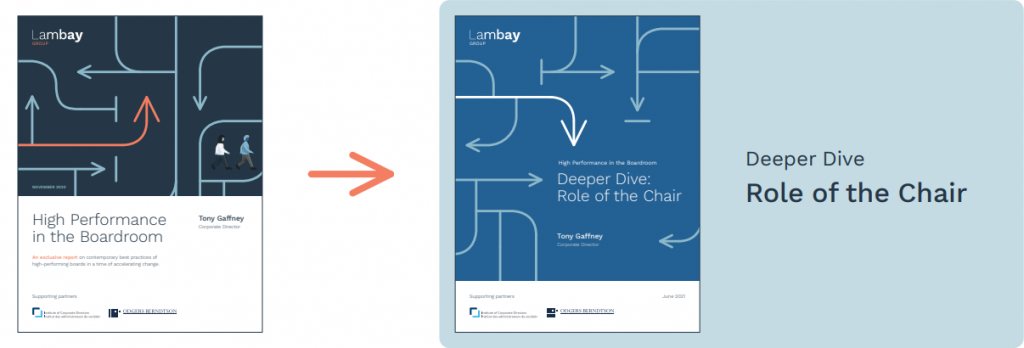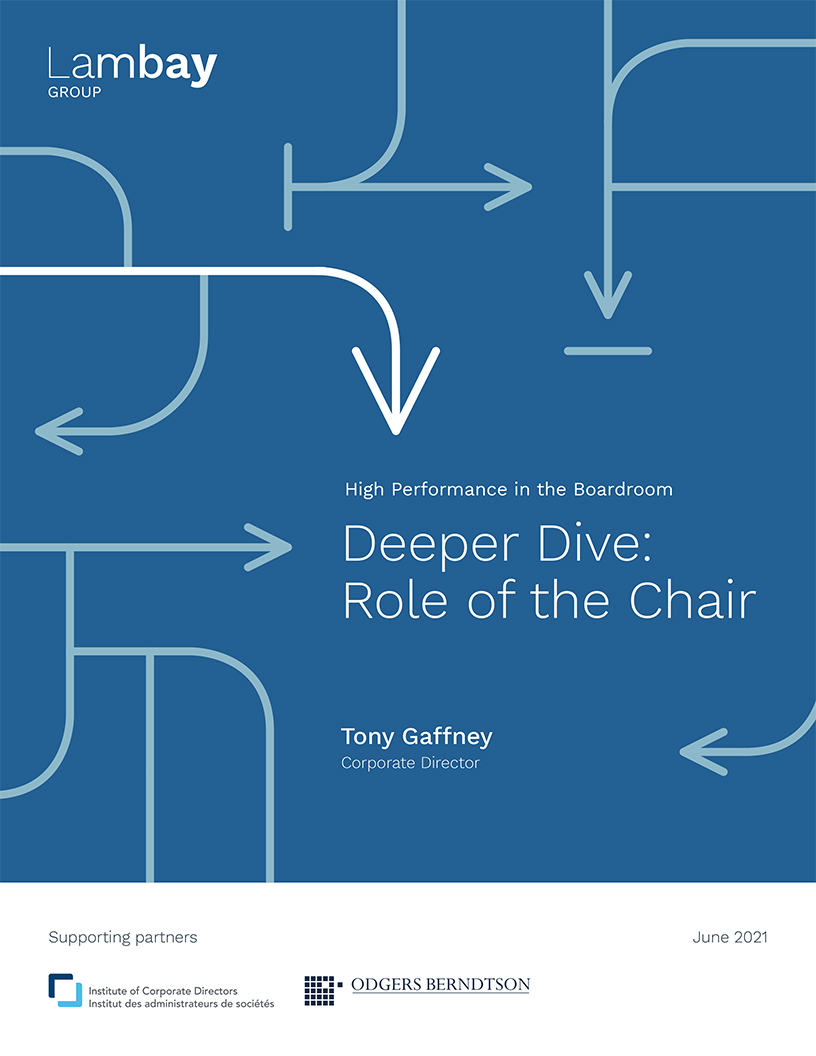
The Discussion Continues Here
The interviews for our plenary report, High Performance in the Boardroom, yielded abundant insights on topics, issues and viewpoints that our participating chairs deemed fundamental. The content was so rich there was no way we could capture it exclusively in one document.
Realizing those additional perspectives and learnings would be invaluable to help our audience probe deeper into critical areas of board, chair and director effectiveness, we created Deeper Dives. It’s a series that will expand and evolve as the dialogue launched with our initial report goes on.
In this installment, we delve into the role of the board chair—a uniquely demanding and critical position in a time of accelerating change.
Read the Deeper Dive
Role of the Chair
Behind every high-performing board of directors is an equally high-performing board chair whose “duty”, according to Don Lowry, chair of the board of Capital Power, “is to be level-headed and comfortable thinking the unthinkable—based on a strong grip of the purpose of your enterprise.”
Chair involvement and engagement, in areas such as agenda setting or working with management, informed the full extent of our main report. However, when we asked our interviewees what they regard as the most important aspects of the role of the chair in the current environment, many of them landed on a number of the same key points.
One area, the chair-CEO relationship, we’ve broken out into a separate Deeper Dive, “Working with the CEO.” The remainder are presented below. The first three roles can be considered either new or rapidly evolving in significance. The other two are fundamental responsibilities taking on added importance as the speed and complexity of change continues.
Always
on call
With boards struggling to cope with an escalating volume of issues and shorter windows to respond, every director is now on call 24/7, says RBC chair Kathleen Taylor. “But as a board chair, you’re in a particularly different situation where you’re not only on call, but you’re on call without a schedule,” she says.
“Your obligation in a crisis is to fit yourself into a schedule that management thinks is useful,” says Taylor. “That requires a fair amount of mental and physical commitment. You’ve got to be physically present more often, you’re expected to do lots of things as a board chair that you might never be asked to do as a regular director.”
Board-management
intermediary
The days when a chair’s main job was just to run board meetings are long gone. Superseding that, according to several of the chairs we interviewed, is the role of intermediary between management and the board. “You’re an ambassador between the two,” says Hal Kvisle, chair of the boards of ARC Resources and Finning.
In conjunction with that, Kvisle says, he also participates in meetings between committee chairs and their department head counterparts in management. “It’s these interface roles that are so important today,” says Kvisle, “and this puts a ton of extra burden on boards.”
The view is echoed by David Lever, chair at McCarthy Tétrault.
“It used to be the chair was just sort of the lead director and they didn’t do much more than process,” says Lever. “The role now is interrelating between management and the board.”
Performance
evaluator
Heightened scrutiny of board composition coupled with the growing need for ongoing director education demands a corresponding step up in director performance evaluation. While evaluation methods vary, board chairs are ultimately responsible for seeing they are done and, more pointedly, for ensuring that directors are held to account for their performance.
“The chair has just as much responsibility for managing the performance of the board as the CEO does of managing the performance of his or her management team,” says John Cassaday, chairman of the board at Manulife.
Board evaluation has changed, agrees Sun Life Financial chair Bill Anderson. “It’s always been there, but it was more to deal with clear director problems. And sometimes even then you didn’t always deal with it effectively. There is more onus today to properly manage director performance.”
Gay Lea Foods recently revamped the board’s existing evaluation process by bringing in a third-party advisor to conduct interviews, compile a report and, at the end of the process, work with each director to create a personal development plan. “People can take offence to certain things,” chair Rob Goodwill says. “This way, it’s about becoming better, raising our board to the next level.”
Along with the individual plans, the consultant helps prepare a report on areas of improvement for the board overall. “To me, as chair, it is priceless,” says Goodwill. “It’s a fabulous document, it gives you a number of things you can work on.”
“The chair has just as much responsibility for managing the performance of the board as the CEO does of managing the performance of his or her management team”
John Cassaday
Setting
the tone
Leadership has always been part of the chair role, but as the stakes rise, so does the premium on this key trait. In recent years at Magna, for example, chair Bill Young has been active in engaging with shareholders, helping to kickstart an important strategic planning process and stepping in to chair a key committee at a critical time. “My sense was that it could upend the dynamic around the board table, so we had to manage that carefully,” he says of the last measure.
For Alectra’s chair Norman Loberg leadership includes attending all board committee meetings. “My attendance is really appreciated by the committee chairs. I enjoy attending and participating. It gives me great insight into the detailed workings of the board. It’s important to ensure that continuity exists through all the committees. And if a question arises, I can assist based on what might have been discussed at other committee meetings.”
Implicitly or explicitly, a chair’s leadership also extends beyond just the board, to include management. “Within a company, employees are looking to the senior executives, and the senior executives are looking to the board for direction,” says Ian Bourne, former chair of Ballard Power Systems. “If you’re running around like the world is coming to a screeching halt, you’re probably not going to be very effective. As a board chair, you’ve got to set the tone.”
Be a
conductor
There is some overlap here with the intermediary role, but the focus is limited to the board and fellow directors while spanning a wider range of concerns.
“As a board chair, you’ve got to draw out your colleagues to the best of your abilities and their abilities,” says Bourne.
“Engagement, positive engagement, in committee meetings and at broader board meetings—that leadership has to start with the chair,” adds York University chair Paul Tsaparis.
The term “conductor” comes from Lowry. As he describes it: “The decision making, experience and skill set that the directors bring to the board needs to be brought out in a manner that you benefit by the diversity of that board and they’re not single voices shouting alone or silent.”
Different chairs take different approaches, but fulfilling these requirements usually depends on a combination of tactics employed during meetings as well as in one-on-one conversations between the chair and individual directors outside those sessions.
Says Lowry: “My job as chair—I’ve learned watching others do this—is that often we go around the table. I ask each director, what’s your view on this particular subject? Do you need any more information? What’s your concern?”
As well as including all the directors, this approach “is helpful for management because, otherwise, the quiet directors don’t always speak up. And that can make it difficult for management to synthesize what’s the feedback, the resolution.”
Outside of board meetings, Brenda Eprile, chair of Westport Fuel Systems, says she devotes a lot of one-on-one time with directors. “It’s very time consuming. I spend a lot of time getting to know the directors as people, to understand where they’re coming from, what issues matter to them, what they are good at.
“Everyone’s views are really important,” says Eprile. “So, the board chair drawing them out is very helpful.”

© 2020, Lambay Group Inc. All rights reserved.
How to cite this document
Tony Gaffney, High Performance in the Boardroom: an exclusive report on contemporary best practices of high-performing boards in a time of accelerating change. https://lambaygroup.com/report/high-performance-in-the-boardroom/
